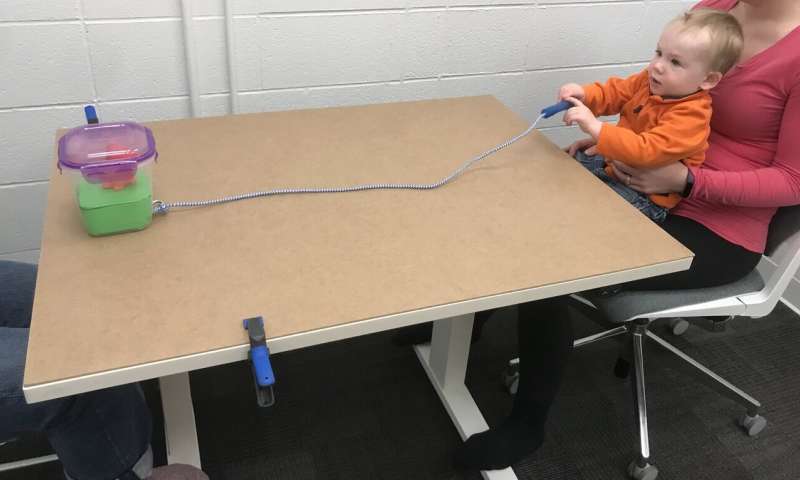
They might not yet speak in complete sentences, but 18-month-olds are savvy when it comes to deciding when and how to try.
According to a study from Arizona State University, the University of Washington and University of Toronto that has implications for how people learn, infants do not try things at random or simply mimic what they see adults doing. Instead, they combine information from their own firsthand experience and the experiences of other people to decide whether to persist in trying to solve a problem. The study will be published in Nature Human Behaviour on January 20.
“Persistence is important and plays a role in learning and life outcomes like school performance and emotional well-being,” said Kelsey Lucca, assistant professor of psychology at ASU and first author on the paper. “But, it’s not always a good idea to persist because effort is a limited resource, and deploying effort is metabolically costly, requiring time and energy. What truly drives learning is knowing when to try and what the best way to try is.”
Nevertheless, the infant persisted
The research team devised an experiment that provided 18-month-old infants with social information and first-hand experience when solving a problem. Each of the 96 infants who participated in the experiment sat on their parent’s lap at a table. Just out of reach on the table was a clear box with a toy inside. The box had a rope attached to it, and an experimenter seated at the table showed the infant how the rope could be pulled to bring the box, and the toy inside, within reach.
The infants saw one of three scenarios: the experimenter easily move the box, the experimenter struggle but ultimately succeed in moving the box, or the experimenter fail to move the box. In the first scenario, the experimenter pulled the rope and easily moved the box across the table on the first try. In the second scenario, the experimenter tried pulling on the rope five times and succeeded on the fifth try. The final scenario was the same as the second, except the experimenter was unsuccessful at moving the box and gave up after the fifth attempt.
Then it was the infants turn to try. Unbeknownst to the them, the experimenter had switched the box for one that was affixed to the table and impossible to move. The infants had three chances to move the box, and on each attempt the research team measured how much time they spent pulling the rope and how hard they pulled.
The infants who saw the experimenter fail to move the box or easily succeed at moving it spent progressively less time trying to move the box with each attempt. Only the infants who watched the experimenter struggle but then succeed persisted in trying to move the box. These infants spent about the same amount of time on each attempt.
“This finding suggests that the toddlers engaged in a sophisticated decision-making process, similar to how adults might create a list of pros and cons and use it to influence their choice,” said Jessica Sommerville, professor of psychology at the University of Toronto and senior author on the paper. “The toddlers computed the utility, or usefulness, of trying to move the box by weighting the potential costs of what they had to lose—whether it was worth it keep pulling the rope—against what they had to gain in terms of the likelihood they could access the toy.”
How hard the infants pulled on the rope was also related to what they watched the experimenter demonstrate. The infants who saw the experimenter fail to move the box did not pull the rope as hard as the two other groups who saw the experimenter succeed in moving the box. The infants who saw the experimenter easily move the box pulled the rope the hardest, and the infants who saw the experimenter struggle and succeed ramped up how hard they pulled on the rope with each attempt, suggesting both these two groups were confident they would be able to move the box by increasing their effort.
Infant inferences
After the three impossible trials, the research team again switched the box, this time for one that could move. On these trials, all three groups of infants successfully moved the box and accessed the toy inside.
The research team examined whether the infants showed help-seeking behaviors like pointing or reaching towards the box. The infants only sought help when they actually needed it, on the attempts when the box was affixed to the table and impossible to move. They did not ask for help on the trials when the box was moveable.
The infants who saw the experimenter easily move the box requested help more than the other two groups, which indicates that the infants also only sought help when they knew it would be useful.
“The infants who saw the experimenter easily move the box traded off trying for help seeking, suggesting that they realized the most adaptive strategy in that context was to get help from someone who can solve the problem,” Lucca said. “The infants who saw the experimenter struggle but succeed needed the least amount of support to solve the task—suggesting that demonstrations of hard work and effort have carry over effects that impact infants’ motivation in future tasks.”
The team also assessed whether the infants’ facial expressions showed positive or negative emotions while they tried to move the box. The infants who saw the experimenter easily move the box showed the most frustration, because their expectations for what was supposed to happen did not match their experience. These infants also required the most prompting to try and move the box on the trials when it was moveable.
Source: Read Full Article
